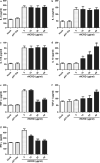Characterization of a rhodanese homologue from Haemonchus contortus and its immune-modulatory effects on goat immune cells in vitro
- PMID: 32894178
- PMCID: PMC7487571
- DOI: 10.1186/s13071-020-04333-6
Characterization of a rhodanese homologue from Haemonchus contortus and its immune-modulatory effects on goat immune cells in vitro
Abstract
Background: Modulation of the host immune response by nematode parasites has been widely reported. Rhodaneses (thiosulfate: cyanide sulfurtransferases) are present in a wide range of organisms, such as archaea, bacteria, fungi, plants and animals. Previously, it was reported that a rhodanese homologue could be bound by goat peripheral blood mononuclear cells (PBMCs) in vivo.
Methods: In the present study, we cloned and produced a recombinant rhodanese protein originating from Haemonchus contortus (rHCRD), a parasitic nematode of small ruminants. rHCRD was co-incubated with goat PBMCs to assess its immunomodulatory effects on proliferation, apoptosis and cytokine secretion.
Results: We verified that the natural HCRD protein localized predominantly to the bowel wall and body surface of the parasite. We further demonstrated that serum produced by goats artificially infected with H. contortus successfully recognized rHCRD, which bound to goat PBMCs. rHCRD suppressed proliferation of goat PBMCs stimulated by concanavalin A but did not induce apoptosis in goat PBMCs. The production of TNF-α and IFN-γ decreased significantly, whereas secretion of IL-10 and TGF-β1 increased, in goat PBMCs after exposure to rHCRD. rHCRD also inhibited phagocytosis by goat monocytes. Moreover, rHCRD downregulated the expression of major histocompatibility complex (MHC)-II on goat monocytes in a dose-dependent manner, but did not alter MHC-I expression.
Conclusions: These results propose a possible immunomodulatory target that may help illuminate the interactions between parasites and their hosts at the molecular level and reveal innovative protein species as candidate drug and vaccine targets.
Keywords: Haemonchus contortus; Immunomodulation; Peripheral blood mononuclear cell (PBMC); Rhodanese.
Conflict of interest statement
The authors declare that they have no competing interests.
Figures








Similar articles
-
Modulatory functions of recombinant electron transfer flavoprotein α subunit protein from Haemonchus contortus on goat immune cells in vitro.Vet Parasitol. 2020 Dec;288:109300. doi: 10.1016/j.vetpar.2020.109300. Epub 2020 Nov 1. Vet Parasitol. 2020. PMID: 33152677
-
Characterization of a secreted macrophage migration inhibitory factor homologue of the parasitic nematode Haemonchus Contortus acting at the parasite-host cell interface.Oncotarget. 2017 Jun 20;8(25):40052-40064. doi: 10.18632/oncotarget.16675. Oncotarget. 2017. PMID: 28402951 Free PMC article.
-
Characterization of a secreted cystatin of the parasitic nematode Haemonchus contortus and its immune-modulatory effect on goat monocytes.Parasit Vectors. 2017 Sep 18;10(1):425. doi: 10.1186/s13071-017-2368-1. Parasit Vectors. 2017. PMID: 28923082 Free PMC article.
-
RNA-Sequencing in Elucidating Immune Responses to Haemonchus contortus Infection in Small Ruminants: Systematic Review.Parasite Immunol. 2025 May;47(5):e70009. doi: 10.1111/pim.70009. Parasite Immunol. 2025. PMID: 40369966 Free PMC article.
-
A Comprehensive Review on Haemonchus contortus Excretory and Secretory Proteins (HcESPs): TH-9 stimulated ESPs as a potential candidate for Vaccine Development and Diagnostic Antigen.Acta Trop. 2024 Dec;260:107462. doi: 10.1016/j.actatropica.2024.107462. Epub 2024 Nov 10. Acta Trop. 2024. PMID: 39527996 Review.
Cited by
-
Genomes of Vibrio metoecus co-isolated with Vibrio cholerae extend our understanding of differences between these closely related species.Gut Pathog. 2022 Nov 20;14(1):42. doi: 10.1186/s13099-022-00516-x. Gut Pathog. 2022. PMID: 36404338 Free PMC article.
-
Recombinant dynein light intermediate chain of Haemonchus contortus affects the functions of goat immune cells in vitro.Parasitol Res. 2022 Jun;121(6):1699-1707. doi: 10.1007/s00436-022-07510-x. Epub 2022 Apr 18. Parasitol Res. 2022. PMID: 35435508
-
In vitro characterization of Haemonchus contortus trehalose-6-phosphate phosphatase and its immunomodulatory effects on peripheral blood mononuclear cells (PBMCs).Parasit Vectors. 2021 Dec 20;14(1):611. doi: 10.1186/s13071-021-05115-4. Parasit Vectors. 2021. PMID: 34930417 Free PMC article.
-
Fasciola gigantica tegumental calcium-binding EF-hand protein 4 exerts immunomodulatory effects on goat monocytes.Parasit Vectors. 2021 May 22;14(1):276. doi: 10.1186/s13071-021-04784-5. Parasit Vectors. 2021. PMID: 34022913 Free PMC article.
-
Neutrophil extracellular traps induced by Haemonchus contortus excretory-secretory proteins varies among goats, gerbils, and mice.Parasit Vectors. 2025 Jul 28;18(1):304. doi: 10.1186/s13071-025-06956-z. Parasit Vectors. 2025. PMID: 40721816 Free PMC article.
References
-
- Besier RB, Kahn LP, Sargison ND, Van Wyk JA. The pathophysiology, ecology and epidemiology of Haemonchus contortus infection in small ruminants. Adv Parasit. 2016;93:95–143. - PubMed
-
- Behnke JM, Williams DJ, Hannah J, Pritchard DI. Immunological relationships during primary infection with Heligmosomoides polygyrus (Nematospiroides dubius): the capacity of adult worms to survive following transplantation to recipient mice. Parasitology. 1987;95:569–581. - PubMed
-
- Maizels RM, Blaxter ML, Scott AL. Immunological genomics of Brugia malayi: filarial genes implicated in immune evasion and protective immunity. Parasite Immunol. 2001;23(7):327–344. - PubMed
-
- Else KJ. Have gastrointestinal nematodes outwitted the immune system? Parasite Immunol. 2005;27:407–415. - PubMed
-
- van Riet E, Hartgers FC, Yazdanbakhsh M. Chronic helminth infections induce immunomodulation: consequences and mechanisms. Immunobiology. 2007;212:475–490. - PubMed
MeSH terms
Substances
Grants and funding
LinkOut - more resources
Full Text Sources
Research Materials

